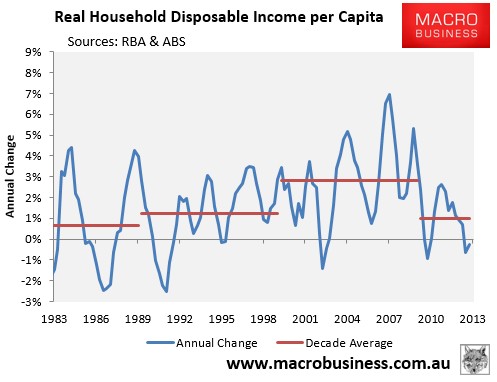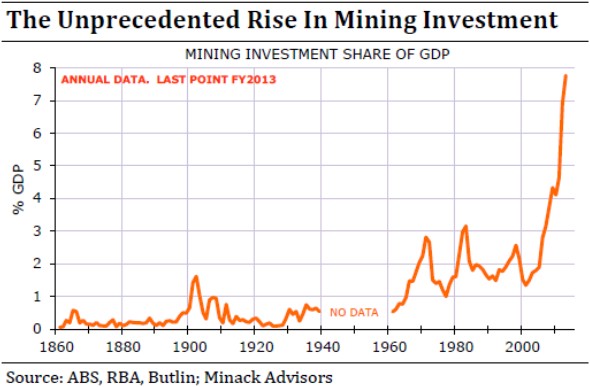
The Australian’s Judith Sloan has today written an article aimed at debunking claims that the mining boom has not benefited Australia, arguing instead that we as a nation “hit the jackpot”:
The rise in the terms of trade, which commenced in 2003, was both greater and more prolonged than anything ever experienced in Australia. We effectively won the lottery; all of sudden, buyers were prepared to pay more for the commodities in which we have a comparative advantage…
In the decade ending in 2012, GDP rose 44 per cent while gross national income (“the value of dollars in our pockets”) rose 63 per cent. “The terms of trade improvement alone directly increased national income by around 13 per cent over that time”…
Another indication of the enormity of the mining boom is the investment that was directly spurred by the higher commodity prices… From a long-run average of about 2 per cent of GDP, mining investment shot up to 10 per cent at the peak of the boom…
Having won the lottery, Australians should pat themselves on the back for handling the windfall gain very well. In the past, we managed to blow up mining booms very quickly. But this time around the benefits have been widely dispersed and sustained.
By and large, I agree with Sloan’s position.
The massive pay rise Australia received for the goods that it sold to the rest of the world – including: iron ore, coal, gold – meant that Australia’s national disposable income (NDI) grew at a much faster rate than output, as measured by GDP . In turn, this process made Australians much wealthier, since a far larger amount of imports could be purchased from a given amount of exports.
To illustrate, consider the below chart comparing Australia’s GDP (output) per capita against national disposable income (NDI) per capita. Since June 2003, when the commodity price boom kicked-off in earnest, per capita GDP has risen by 15%, whereas per capita NDI has risen by 22%, with 7% difference a pure income gain to Australians:

Household incomes also benefited from the boom in commodity prices and the terms-of-trade. As shown below, real average household disposable income per capita grew by a whopping 2.8% per annum over the 2000s – well above the 0.7% average growth rate experienced over the 1980s or the 1.2% average growth rate experienced over the 1990s:

And as shown recently by Gerard Minack, the boom in mining investment has also been extraordinary, which has helped boost output, income and employment:

My only area of contention with Sloan’s argument is the notion that Australia has managed the proceeds of the once-in-a-century mining boom well. The way I see it, Australia has failed to capture enough of the windfall gains via the tax system. Governments were also too loose with their spending, particularly in the areas of middle-class welfare and superannuation (a fact also acknowledged by Sloan). Accordingly, the Budget is in a weaker position going forward than it should have been.
In hindsight, Australia should have emulated Norway, implemented a proper resources rents tax, and established a sovereign wealth fund to store away much of the windfall gains. But we didn’t.
Similarly, Australia’s governments have failed to invest adequately in infrastructure, leaving a huge deficit that is being made worse by rapid population growth (in part driven by the boom).
Overall, the mining boom was like a manna from heaven for Australia. However, we have managed the process badly, leaving the economy exposed as the boom unwinds.

